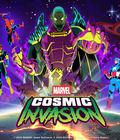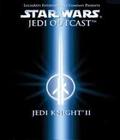Porting games is an art. Sometimes it's relatively painless, such as going from one console to another in the same generation. Other times, the job can feel like making a whole new game from scratch, such as when moving a PC game to a console when the original didn't have console controls in mind in the first place. When the port for Star Wars Jedi Knight II: Jedi Outcast happened in 2002, people were stunned at how the game came out so well on the Nintendo GameCube. With the latest port of the game to the Nintendo Switch, people are wondering how things went so wrong.
Jedi Outcast takes place at a time when Star Wars lore was more free-form, and the story still works well today even if you have no prior knowledge of the prequel, Star Wars Jedi Knight: Dark Forces II. You play the role of Kyle Katarn, a mercenary who once knew how to fight like a Jedi. After the events of the last game, he turned his back on the teachings and went back to his old ways. A mission from Senator Mon Mothma brings Kyle and his partner Jan Ors to an abandoned Empire outpost to investigate some disturbances.
The setup works fine for a story beat, but it means that you aren't going to wield a lightsaber at the beginning of the game. In fact, it takes some time before you get to that point, so the opening levels are more like a return to the Dark Forces way of doing things. There are some decently sized hallways that funnel into larger areas, where Stormtroopers start attacking you with a combination of rushing and zigzagging. Classic switch-based puzzles have you hunting for something to unlock doors or activate machinery to open the doors. Health and armor don't regenerate, so you'll need to find pick-ups and refill stations. There are a few jumping areas, but this mostly consists of old-school running and gunning.
For those who haven't played the classic Doom on the Switch or the bulk of Quake 3 Arena-era games on the PC, the experience is frantic but can be lots of fun, as you'll run around dodging fire and scoring some hits. That isn't the case here, and the bulk of that blame can be placed on the porting of the PC code to the Switch. Dual analog controls have done wonders for first-person shooters, but the only way they can compensate for the quickness and accuracy of the keyboard/mouse combo is to throw in slight auto-aim and lock-on to make the experience more user-friendly. The port by Vicarious Visions did that well on the GameCube, but none of that was applied to the Switch.
The removal of those elements leads to a game where you're less of a heroic mercenary and more of a classic Stormtrooper, as you'll miss most of your shots in firefights. Things fare better when you start to move slowly, but that goes against the spirit of the game's gunfights. That pace also becomes the only way to get through the opening levels, since the checkpoint system is infrequent. Given the number of times you'll die in the game, either because you're trying to find the exit and accidentally get someone killed or because you take in more shots than you can give, you'll make it a habit to save way too often.
It takes roughly five levels before you reach the Valley of the Jedi, and from here, the game seems like it is apologizing for putting you through the gunplay by finally giving you the powers of the Force and your trusty lightsaber. With all these in tow, the lack of precision from the analog sticks goes away, as your abilities have a better hit arc to compensate. Being able to combine the Force powers with your lightsaber makes the rest of the game your playground; you'll casually toss around your saber while easily moving around enemies. More importantly, the boss fights become epic duels, since you must carefully plan out your attacks instead of mashing the buttons and hoping you make it out alive. With the gameplay still tight after all these years, the title's back half completely makes up for the clunky first half.
One thing that Aspyr did that mimics the original Xbox and GameCube releases was in how it handles multiplayer. In short, it has none. On the PC, being able to have lightsaber duels with multiple people was what made the game feel different from the likes of Quake 3 Arena and Unreal Tournament. In fact, the multiplayer is still functional today, even though a tiny community remains for this game. Considering that the Switch has none of the Battlefront games, this would've been a perfect opportunity to get some multiplayer Star Wars going on Nintendo's console. Alas, its absence serves as another missed opportunity for console players to engage in lightsaber duels.
Like the rest of the game, the graphics remain mostly unchanged. In a way, that's good, since it means the stark white look of the Empire building interiors looks faithful. On the other hand, the only thing that was changed was an increase in resolution. Some of the characters in cut scenes look wider, as if they were simply squished for widescreen instead of properly scaled out. The polygons haven't gotten an increase, so every character looks chunky. The textures haven't been redone, so you don't have to go that far from an object before you notice that it looks blurry. Everything does run with 60fps at all times, but unless you're willing to treat this as a product of its time and not compare it to modern titles, this isn't exactly a showcase title for either the Switch or for porting older games to newer hardware.
At the very least, the sound fares a little better. The music, both the snippets of the classic John Williams score and the original material produced specifically for the game, remains exquisite and nails the feeling of the films of the original trilogy. Likewise, the sound effects nail those iconic sounds, like lightsabers cutting through the air or the blasters firing and sometimes hitting a target. The voice work is also done well, with a bunch of industry veterans lending their pipes to some classic character performances that still stand the test of time. The only bugbear is that this is all still done in basic stereo, and with all of the action happening on-screen, a good surround sound mix would've done wonders to amplify the action.
At its core, Star Wars Jedi Knight II: Jedi Outcast remains a good title. Get past the shooting, and you're rewarded with a ton of Force powers and lightsaber combat that remains at the top of its field to this day. However, the port job isn't up to snuff, as it lacks some slight auto-aim and lock-on to make the experience more user-friendly for console players, so the opening levels are a real chore to get through even if you can handle the outdated textures and adherence to the old way of doing puzzles. Not only is it recommended to go with the PC release for this title, but it also gives one pause about how the eventual port job of Jedi Academy will turn out.
Score: 6.0/10
More articles about Star Wars Jedi Knight II: Jedi Outcast










 May the Force be with you as Kyle Katarn, agent of the New Republic, our only hope to stop a rogue Jedi.
May the Force be with you as Kyle Katarn, agent of the New Republic, our only hope to stop a rogue Jedi.




